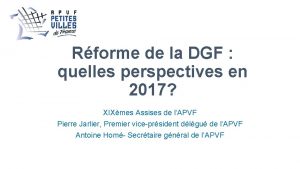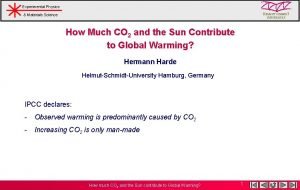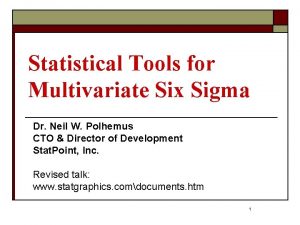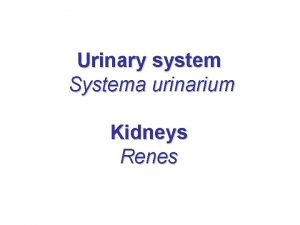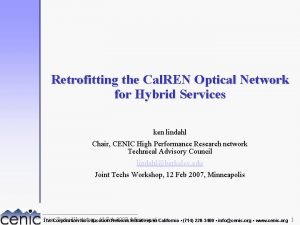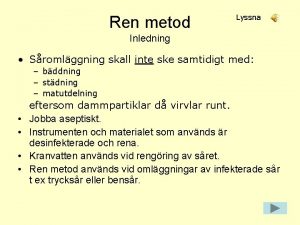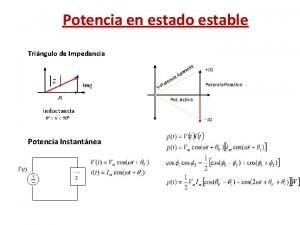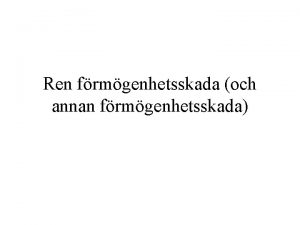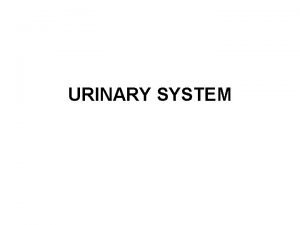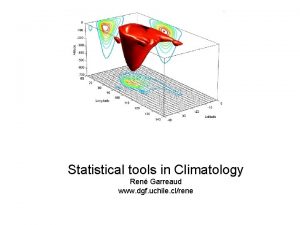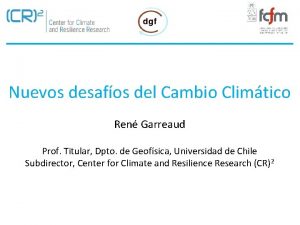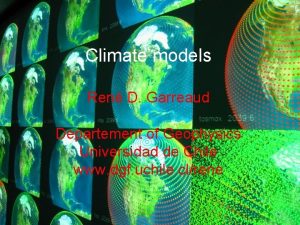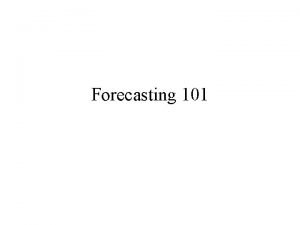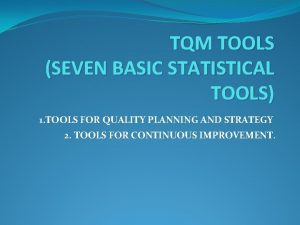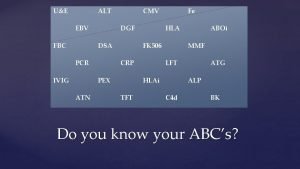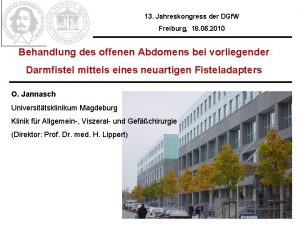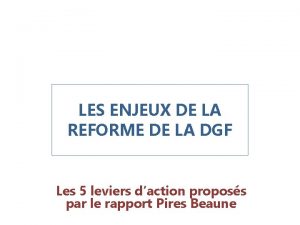Statistical tools in Climatology Ren Garreaud www dgf






























- Slides: 30

Statistical tools in Climatology René Garreaud www. dgf. uchile. cl/rene

Fundamental problem in (paleo) Climatology: How to link local-scale phenomena with large scale atmospheric patterns (if there such a link)? Local signal Internal dynamics Large scale climate Example of local scale signals: Rainfall, wind, temperature, tree-ring growth, lake level, wet deposition, charcoal accumulation, etc. Some times, we have local events: heavy rainfall, extended drought, lake desiccation, etc. Example of large scale climate: wind patterns, SST, precipitation elsewhere, etc….

Gridded Analysis: set of maps with data on a regular grid (e. g. , lat-lon, lon-lev) • Spatial structure at a given time (displayed with isolines or colors) • Time series at each grid point time n time 4 time 3 time 2 time 1 lat erie es Latitude Tim Map lon Longitude s at a d fixe p grid t oin

Basic Operation with gridded data Mean and Std Deviation time 4 time 3 time 2 lat time 1 Standard deviatio n Mean field Average, standard deviation and other statistical parameters (max, min, skewness, etc. ) are calculated using the time series at each grid point

Example of mean fields…

Basic Operation with gridded data Compositing Analysis (composite map). Anomalies time n Event! time 4 Event! time 3 time 2 lat time 1 Here one can use a univariate method (e. g. , t-test) at each point to test for statistical significance of the anomalies All mean Composite mean _ Composite anom alies =

Example of compositing analysis…spatial fields

Cold minus Warm composites to enhance signal

Composite maps of (a, b) rainfall and (c, d) SST anomaly overlaid on vectors of wind stress anomaly during dry and wet years. ® Mathew England 2005

Use compositing analysis to describe the spatial structure of selected climate variables during the occurrence of events at your site. SLP elsewhere Sometime, the events are associated to extreme values of a continuous time series. In this case, you can also use regression analysis (1 Point correlation map), but the later method will fail if there is no a linear relationship… Your events Your site specific variable

Basic Operation with gridded data 1 Point Correlation Map var f so e Tim rie e S ia X e l b time n time 4 time 3 time 2 time 1 lat time 1 ble f o s Correlation map p a M Here one can use a univariate method at each point to test for statistical significance of correlation ria a V Y

Annual mean Precip/SAT regressed upon index of large-scale modes (50 years of data)

How is the spatial pattern of SST when there is above/below normal Rainfall over the Altiplano?

Basic Operation with gridded data Point-Point Correlation Map time n time 3 time 4 time 2 time 3 time 1 time 4 time 2 le b a ri X a ps Ma V of Correlation map a ble f o ps ri a V Ma Here one can use a univariate method at each point to test for statistical significance of correlation Y

Precipitación en latitudes medias Garreaud 2007

Your Time Series may contain • Strong annual cycle (if or monthly data is available) • Moderate (but important) interannual or interdecadal variability • Long term trends • Errors! Need to examine and pre-filter data before analysis

Large annual cycle Small interannual variability Small annual cycle Large interannual variability Intraseasonal noise?

Nice trend Moderate annual cycle Some noise… Abrupt climate change? Strong annual cycle?

Stgo. Rainfall 1 -Point Correlation map Stgo. Rainfall – 1000 h. Pa air temperature Full time series Mix regular cycles and interannual variability

Stgo. Winter Rainfall 1 -Point Correlation map Stgo. Winter Rainfall – 1000 h. Pa air temperature

Alternatively, use the anomaly filter, i. e. substract annual mean cycle Caution with seasonally dependent signal Full time series Annual cycle Anomaly time series Mean annual cycle Anomalies

Caution with seasonally dependent signal 1 Point Correlation Map between U 300’ over the Andes and Precipitation DJF JJA All months

So far we have analyzed data at one site and its association with global fields. Global fields have spatial coherence and some common temporal variability arising from internal variability (e. g. ENSO) U 300 winter Stgo Winter Precip

EOF / PC Analysis • Powerful method to synthesize (large) data sets • Allows to obtain the mode(s) that explain most of the variance in the data • Each mode composed by a spatial pattern (EOF), time pattern (PC, loading factors) and fraction of variance accounted by • It uses linear algebra: EOF/PC are linear combination of original data • EOF = Empirical orthogonal functions (instead of analytical orthogonal functions)

EOF / PC Analysis • • User has to decide spatial domain (large-small) Pre-filter data (at least remove mean field) How many modes are retained (North’s rule) Each mode is orthogonal with the rest…not always true in nature • Rotated EOFs / Extended EOFs

Synthesized information Original data time 1 time 2 Let the data speak by itself X(space) time 3 variable Leading EOF (dominant mode) EOF Analysis time 5 X(space) Principal Component loading variable time 4 1 2 3 4 5 …. . N time : fraction of variance accounted by a mode time N X(space)


Otros ejemplos de EOF

Otros ejemplos: Rotated EOF Many other techniques…. but keep it simple

 Dgf
Dgf International satellite cloud climatology project
International satellite cloud climatology project Equatorial comfort index
Equatorial comfort index International satellite cloud climatology project
International satellite cloud climatology project Descriptive statistical tools
Descriptive statistical tools The seven quality control tools
The seven quality control tools Six sigma statistical tools
Six sigma statistical tools The appropriate cutting tool used in cutting fabrics
The appropriate cutting tool used in cutting fabrics Polus vascularis
Polus vascularis Cal ren
Cal ren Ren metod
Ren metod Emily ren
Emily ren Ren fungiformis
Ren fungiformis Ni jia you ji ge ren in english
Ni jia you ji ge ren in english Max yi ren
Max yi ren Ren x sen
Ren x sen Systema urinarium
Systema urinarium Ren.dentalofficetoolkit
Ren.dentalofficetoolkit Ren nai
Ren nai đạo đức trí tuệ nghị lực
đạo đức trí tuệ nghị lực Potencia reactiva
Potencia reactiva Ren förmögenhetsskada
Ren förmögenhetsskada Lesren
Lesren Ren descartes
Ren descartes Ren arcuatus
Ren arcuatus Ren thailand
Ren thailand Proportzio anizkoitzen legea
Proportzio anizkoitzen legea Ren energie
Ren energie Ren apparaat
Ren apparaat Glandula paraurethrales
Glandula paraurethrales Sean ren
Sean ren
